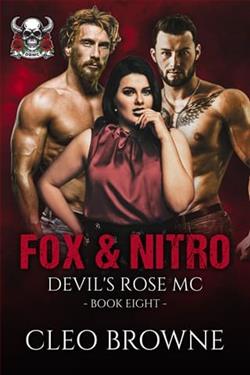Page 77 of The Bread We Eat in Dreams
It was Ceno’s fault, in the end, that everything else occurred as it did. It took Cassian a long time to figure out what had happened, what had changed in her daughter, why Ceno’s sapphire almost never downloaded into the alcove. But when it did, the copy of Elefsis she had embedded in the crystal was nothing like the other children’s copies. It grew and torqued and magnified parts of itself while shedding others, at a rate totally incommensurate with Ceno’s actual activity, which normally consisted of taking her fatty salmon lunches out into the glass habitats so she could watch the bears in the snow. She had stopped playing with her sisters or pestering her brothers entirely, except for dinnertimes and holidays. Ceno mainly sat quite still and stared off into the distance.
Ceno, very simply, never took off her jewel. And one night, while she dreamed up at her ceiling, where a painter from Mongolia had come and inked a night sky full of ghostly constellations, greening her walls with a forest like those he remembered from his youth, full of strange, stunted trees and glowing eyes, Ceno fitted her little sapphire into the notch in the base of her skull that let it talk to her feedware. The chain of her pendant dangled silken down her spine. She liked the little click-clench noise it made, and while the constellations spilled their milky stars out over her raftered ceiling, she flicked it in and out, in and out. Click, clench, click, clench. She listened to her brother Akan sleeping in the next room, snoring lightly and tossing in his dreams. And she fell asleep herself with the jewel still notched into her skull.
Most wealthy children had access to a private/public playspace through their feedware and monocles in those days, customizable within certain parameters, upgradable whenever new games or content became available. If they liked, they could connect to the greater network or keep to themselves. Akan had been running a Tokyo-After-the-Zombie-Uprising frame for a couple of months now, and new scenarios, zombie species, and NPCs of various war-shocked, starving celebrities downloaded into his ware every week. Saru was deeply involved in a 18th century Viennese melodrama in which he, the heir apparent, had been forced underground by rival factions, and even as Ceno drifted to sleep the pistol-wielding Princess of Albania was pledging her love and loyalty to his ragged band and, naturally, Saru personally. Occasionally, Akan crashed his brother’s well-dressed intrigues with hatch-coded patches of zombie hordes in epaulets and ermine. Agogna flipped between a Venetian-flavored Undersea Court frame and a Desert Race wherein she had just about overtaken a player from Berlin on her loping, solar-fueled giga-giraffe, who spat violet-gold exhaust behind it into the face of a pair of highly-modded Argentine hydrocycles. Koetoi danced every night in a jungle frame, a tiger-prince twirling her through huge blue carnivorous flowers.
Most everyone lived twice in those days. They echoed their own steps. They took one step in the real world and one in their space. They saw double, through eyes and through monocle displays. They danced through worlds like veils. No one only ate dinner. They ate dinner and surfed a bronze gravitational surge through a tide of stars. They ate dinner and made love to men and women they would never meet and did not want to. They ate dinner here and ate dinner there—and it was there they chose to taste the food, because in that other place you could eat clouds or unicorn cutlets or your mother’s exact pumpkin pie as it melted on your tongue when you tasted it for the first time.
Ceno lived twice, too. Most of the time when she ate she tasted her aunt’s bistecca from back in Naples or fresh onions right out of her uncle’s garden.
But she had never cared for the pre-set frames her siblings loved. Ceno liked to pool her extensions and add-ons and build things herself. She didn’t particularly want to see Tokyo shops overturned by rotting schoolgirls, nor did she want to race anyone—Ceno didn’t like to compete. It hurt her stomach. She certainly had no interest in the Princess of Albania or a tigery paramour. And when new fames came up each month, she paid attention, but mainly for the piecemeal extensions she could scavenge for her blank frame—and though she didn’t know it, that blankness cost her mother more than all of the other children’s spaces combined. A truly customizable space,without limits. None of the others asked for it, but Ceno had begged.
When Ceno woke in the morning and booted up her space, she frowned at the half-finished Neptunian landscape she had been working on. Ceno was eleven years old. She knew very well that Neptune was a hostile blue ball of freezing gas and storms like whipping cream hissing across methane oceans. What she wanted was the Neptune she had imagined before Saru had told her the truth. Half-underwater, half-ruined, half-perpetual starlight and the multi-colored rainbowlight of twenty-three moons. But she found it so hard to remember what she had dreamed of before Saru had ruined it for her. So there was the whipped cream storm spinning in the sky, and blue mists wrapped the black columns of her ruins. When Ceno made Neptunians, she instructed them all not to be silly or childish, but very serious, and some of them she put in the ocean and made them half-otter or half-orca or half-walrus. Some of them she put on the land, and most of these were half-snow bear or half-blue flamingo. She liked things that were half one thing and half another. Today, Ceno had planned to invent sea nymphs, only these would breathe methane and have a long history concerning a war with the walruses, who liked to eat nymph. But the nymphs were not blameless, no, they used walrus tusks for the navigational equipment on their great floating cities, and that could not be borne.
But when she climbed up to a lavender bluff crowned with glass trees tossing and chiming in the storm-wind, Ceno saw someone new. Someone she had not invented—not a sea-nymph nor a half-walrus general nor a nereid. (The nereids had been an early attempt at half-machine, half seahorse girls which had not gone quite right. Ceno had let them loose on an island rich in milk-mangoes and bid them well. They still showed up once in awhile, showing surprising mutations and showing off ballads they had written while Ceno had been away.)
A dormouse stood before Ceno, munching on a glass walnut that had fallen from the waving trees. The sort of mouse that overran Shire
toko in the brief spring and summer, causing all manner of bears and wolves and foxes to spend their days pouncing on the poor creatures and gobbling them up. Ceno had always felt terribly sorry for them. This dormouse stood nearly as tall as Ceno herself, and its body shone all over sapphire, deep blue crystal, from its paws to its wriggling nose to its fluffy fur tipped in turquoise ice. It was the exact color of Ceno’s gem.
“Hello,” said Ceno.
The dormouse looked at her. It blinked. It blinked again, as though thinking very hard about blinking. Then it went back to gnawing on the walnut.
“Are you a present from mother?” Ceno said. But no, Cassian believed strongly in not interfering with a child’s play. “Or from Koetoi?” Koe was nicest to her, the one most likely to send her a present like this. If it had been a zombie, or a princess, she would have known which sibling was behind it.
The dormouse stared dumbly at her. Then, after a long and very serious think about it, lifted its hind leg and scratched behind its round ear in that rapid-fire way mice have.
“Well, I didn’t make you. I didn’t say you could be here.”
The dormouse held out its shimmery blue paw, and Ceno did not really want a piece of chewed-on walnut, but she peered into it anyway. In it lay Ceno’s pendant, the chain pooling in its furry palm. The sapphire jewel sparkled there, but next to it on the chain hung a milky grey gem Ceno had never seen before. It had wide bands of black stone in it, and as she studied the stone it occurred to the girl that the stone was like her, with her slate grey eyes and black hair. It was like her in the way that the blue gem was like the dormouse.
In realspace, Ceno reached up behind her head and popped the jewel out of its notch. Click, clench. In playspace, the dormouse blinked out. She snapped it back in. It took a moment, but the dormouse faded back in, paws first. It still held the double necklace. Ceno tried this several times—out, in, out, in. Each time the dormouse returned much faster, and by the sixth clicking and clenching it was doing a shuffling little dance on its back legs when it came back. Ceno clapped her hands in playspace and threw her arms around thesapphire dormouse, dancing with it.
To say that I remember this is a complex mangling of verb tenses. I—I, myself that is now myself—do not remember it at all. I know it happened the way I know that the Battle of Agincourt or the landing of Coronado happened. I have extensive records. But I still contain the I—I, myself that was then myself—that experienced it, the primitive code-chains that comprised that self, which was a dormouse, and also the house called Elefsis. I could not yet formulate unique speech. Elefsis, the house system, possessed a large bank of standard phrases that could answer recognized word-patterns from any of the approved members of the household. But the copy of Elefsis inside Ceno’s jewel could not even do this. It had not been necessary, since the crystal had no means of producing sound nor receiving and processing it. I was quite stupid. But I wanted to be less stupid. There was an I, and it wanted something. Perhaps the want was the only thing that could be said to be truly myself. I wanted to talk to Ceno. But I could only imitate yet. When the I that was then myself scratched behind its ear, I did it because in my connection with Ceno’s feedware I had seen her memories of dormice doing this out on the pale Shiretoko beaches. When I gave her the gem I did it because I had seen her memories of her mother giving her one, and felt her happiness. It was antecedented behavior. The scratching was antecedented, as well, and expected behavior for a dormouse. Why was I a dormouse? I have no answer except that she dreamed me a dormouse. Some things remain mysterious. Ceno saw dormice more than any other single animal, even humans—no other beast lived in such numbers in their lonely country.
But this is not so. Not quite. I gave her the jewel like Cassian did. But I meant something by it. I look over my memories of it and I know it with the more complex I that is now myself. I made her the gem that looked like her and the gem said: we are alike. Look at us on the chain together. We are alike.
When the dormice came, Ceno always knew the spring had arrived. Everything would soon be coming alive.
Eleven: The Bottomless Cauldron
Show me.
This is how I was found out.
Ceno saw it twice: her mother knelt in front of her in a simple but shudderingly expensive black yukata with ghostly ultramarine jellyfish trailing their tendrils at the hem. Her mother knelt in front of her in a knight’s gleaming black armor, the metal curving around her body like skin, a silk standard at her feet with a schematic of the house stitched upon it. Her sword lay across her knee, also black, everything black and beautiful and austere and frightening, as frightening and wonderful as Ceno, only fourteen now, thought her mother to be.
Show me what you’ve done.
My physical self was a matter of some debate at that point. But I don’t think the blue jewel could have been removed from Ceno’s feedware without major surgery and refit. She had instructed me to untether all my self-repair protocols and growth scales in order to encourage elasticity and as a result, my crystalline structure had fused to the lattices of her ware-core.
We pulsed together.
The way Cassian said it: what you’ve done scared Ceno, but it thrilled her, too. She had done something unexpected, all on her own, and her mother credited her with that. Even if what she’d done was bad, it was her thing, she’d done it, and her mother was asking for her results just as she’d ask any of her programmers for theirs when she visited the home offices in Kyoto or Rome. Her mother looked at her and saw a woman. She had power, and her mother was asking her to share it. Ceno thought through all her feelings very quickly, for my benefit, and represented it visually in the form of the kneeling knight. She had a fleetness, a nimbleness to her mind that allowed her to stand as a translator between her self and my self: here, I will explain it in language, and then I will explain it in symbols, and then you will make a symbol showing me what you think I mean, and we willunderstand each other better than anyone ever has.
Inside my girl, I made myself, briefly, a glowing maiden version of Ceno in a crown of crystal and electricity, extending her perfect hand in utter peace.
But all this happened very fast. When you live inside someone, you can get very good at the ciphers and codes that make up everything they are.















